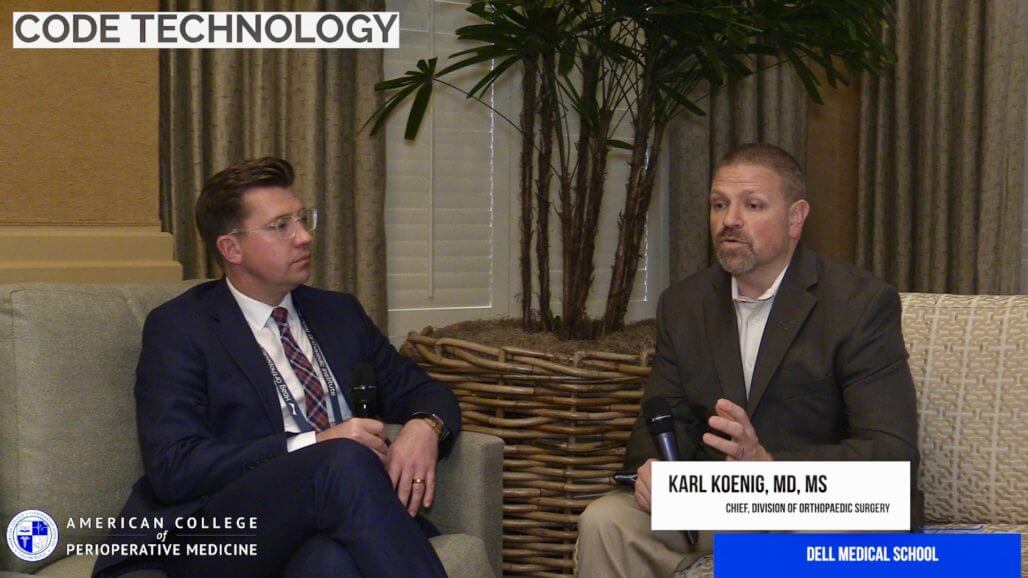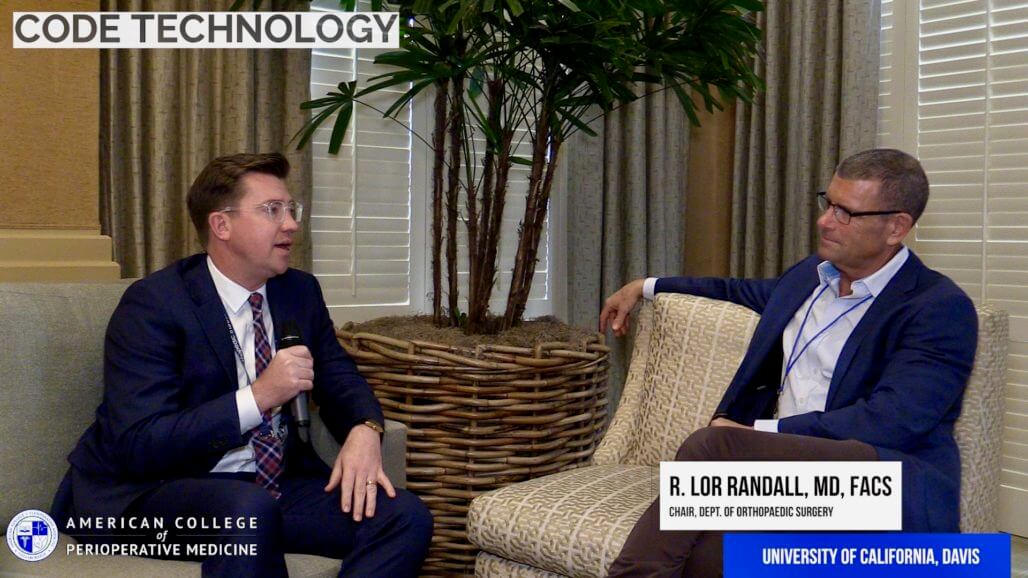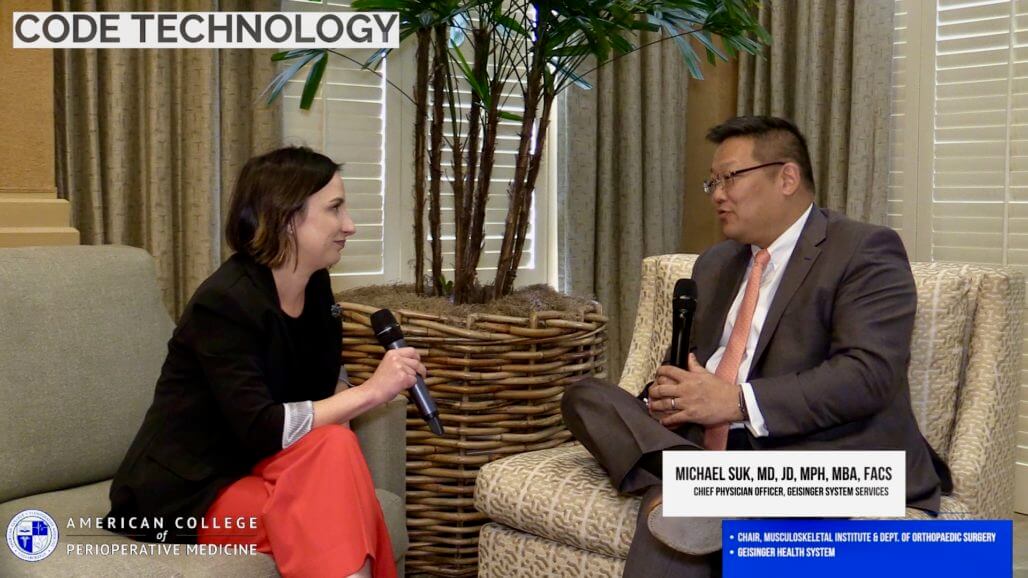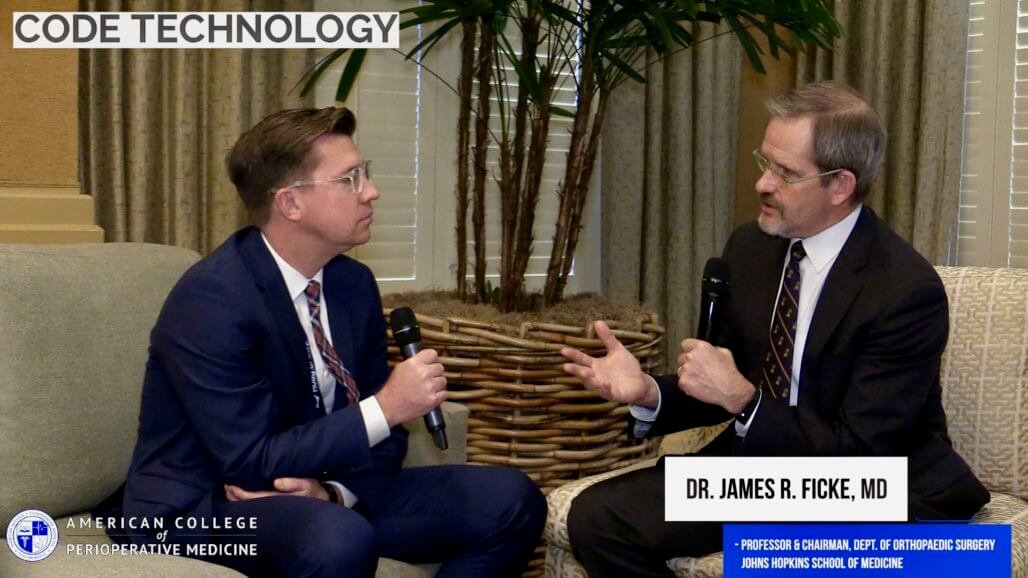Check out the full video interview with Dr. Koenig below
CODE speaking with Dr. Karl Koenig, MD, MS at the 4th Interdisciplinary Conference on Orthopedic Value Based Care 2020
Session Topics:
- Condition-Based Bundles
Interviewee:
Dr. Karl Koenig, MD, MS
Chief, Division of Orthopaedic Surgery
Dell Medical School
Dr. Brian Cunningham:
We’re here at OVBC 2020 and we’re very fortunate to have Dr. Karl Koenig here, a value extraordinaire, currently at UT Austin at the Dell Medical Center. Just gave a great talk on condition-based bundles. For most of us, I think, this transition is confusing. People say volume, people say value. We’re all wading through it. A lot of people have heard about bundle payments. Tell me a little bit about condition-based bundles or payments. Help shed a little bit of light on what that means.
Dr. Karl Koenig:
Sure, Brian. Well, I really appreciate the opportunity and it’s been great to come here and talk with an engaged group of people about this novel alternative payment model. Most people are familiar with procedure-based bundles, at least around hip and knee arthroplasty and spine surgery. So what a condition-based bundle is really, the next step forward in delivering value. So, the issue with procedure-based bundles is that you get what you pay for. You get really efficient procedures and we have definitely moved the needle in terms of if you need a knee replacement, having it done under a bundle is likely to be a lower-cost option and arguably improved outcomes. But it doesn’t say anything about the appropriateness of the procedure.
So, when you’re managing the condition, then you’re actually on the hook for a patient’s outcome whether they are treated non-operatively or whether they’re treated operatively, you still take all those lessons we’ve learned from procedure-based bundles because when you do invest in a surgery, you want it to be very efficient.
Dr. Brian Cunningham:
That’s right.
Dr. Karl Koenig:
And you want to have a great outcome for the patient. But you actually bring appropriateness into the conversation and surgical utilization, which actually does fall under the purview of the surgeon and the system, is something that we take risk on and potentially have a way to build in margin.
Dr. Brian Cunningham:
That’s fantastic. So, let me just dovetail on that for a second. Bundled payments in a procedural sense, walk me through … So you start out and you’re very inefficient and there’s a lot of room to move. As you get more efficient, what keeps the motivation to stay in that bundle?
Dr. Karl Koenig:
That’s exactly the argument that was put forth here today by my colleague Bruce Cohen, is that truly is a race to the bottom. So, for us as musculoskeletal experts, and I don’t just mean orthopedic surgeons, but also the associate providers on our team, physiatrist, rheumatologists that all work together to treat these musculoskeletal diseases, we really need to do disease management. We need to not go the way of the cardiac surgeon, letting a cardiologist take over part of that. The musculoskeletal realm is currently, a lot of it is handled by primary care except for the extreme, but they don’t have very much training in that area. Whereas we’re musculoskeletal experts and we take care of those conditions on a daily basis. So, by actually managing those conditions, not just when they need surgery, but also before they do, and taking risk on that allows us to potentially gain margin from it. So, that’s what a condition-based bundle will do.
And in a procedure-based bundle, we will continue to get more and more efficient procedures, and it’s already a race to the bottom. So several of the largest orthopedic organizations that got into the voluntary bundled payments have now pulled out because there’s no more savings for them to garner. And so the difference here is that for the payer, there is generally a decrease in cost instead of an increase in cost. But the Delta that’s in there is what keeps us motivated.
Dr. Brian Cunningham:
Sure.
Dr. Karl Koenig:
So we look at the investments we make, we look at the resources that we utilize in the care of these conditions as an investment. And then we have to deliver to the payer a measure of our outcomes, and so it works both ways.
Dr. Brian Cunningham:
So would you say that this idea of condition-based bundles and models is a merger between population health and orthopedic bundled payment? Walk me through the interaction between population health and orthopedics and how condition-based bundles fit into that.
Dr. Karl Koenig:
That’s so helpful, Brian, because to me, it really is musculoskeletal population health. What we think about is we care for your musculoskeletal condition in the context of helping you get and stay healthier. And so it actually, it can be very synergistic with the poor primary care provider is dealing with a patient’s hypertension, their cardiac disease, diabetes, and they’ve been asking them to lose weight for years and they’ve been trying to get them to quit smoking. And then you come and you really want to have a joint replacement, and I’m like, Oh, well, we’re going to have to lose some weight to do this and there’s somebody on my team to help do that. And you’re going to have to stop smoking and you can start again, but why would you?
And so sometimes we can actually help the primary care provider and they’re the captains of the health ship, but we really take care of the musculoskeletal population health. Now for musculoskeletal disease, that turns out to be a really big chunk of people’s total cost of care. And so we’re in a position to work well with payers and actually contract with them in a meaningful way. But I think the unit of contracting needs to be moved upstream from just concentrating on procedures and actually the care of the condition.
Dr. Brian Cunningham:
Now, do you think there’s also potentially some kind of a … I’ve heard people call it a halo effect. Or a bigger impact on overall patient health when you can leverage, for instance, the need for total joint arthroplasty to now finally lose a little bit of weight, to now finally stop smoking, to now finally maybe get some mental health and wellness counseling? And now all of a sudden, if you think about the value you’re providing, it’s centered around maybe musculoskeletal care, but it actually trickles into other areas. Is that fair to say?
Dr. Karl Koenig:
Oh, absolutely. And I can show you countless patient examples where that’s really been the case. And some of our most grateful patients have been ones where we were the first ones. So they came in and it was clear that they needed surgery and we… now there was a … there’s this pivotal moment.
Dr. Brian Cunningham:
Right.
Dr. Karl Koenig:
There’s this chance to change and turn the ship. And so, but yes, we get you started on the path to losing weight. I’m thinking of one patient in particular that we helped her to stop smoking. She was on chronic narcotics when we met her. We helped her wean down before the surgery. And then the letter I got back from her, it started out with the typical thing I would hear as a knee replacement surgeon with, thank you, doctor. My knee feels great, I don’t have any pain anymore. And I mean that makes me feel good, but that’s pretty standard for something like a knee replacement. But the rest of her letter where she says, And I went to the grocery store for the first time in a year, and I feel like myself again, and I’m listening to music.
I mean, that’s the kind of life change we want to get into, right? We’re not just delivering healthcare, we’re trying to help people be healthier. And the truth is that it’s more cost-effective to do it that way. Everyone says, Oh, that’s a lot of resources to put into a clinic. But the truth is it’s so much less wasteful to do that and to actually engage with people on their health. So I think there’s a huge halo effect but in a very good way. And I think we have to see ourselves as … I mean, we’re not servants to the primary care providers, but we’re partners with them.
Dr. Brian Cunningham:
That’s right.
Dr. Karl Koenig:
It’s not their job to prep people for surgery for us. We’re all on a team, and we have to work together or the patient doesn’t get better.
Dr. Brian Cunningham:
Yes. Speaking of that team concept, I was fortunate enough to go down and see you down in Austin and see your work and it … to be honest, it was very inspiring. Tell us a little bit about the idea of integrated practice units and how you think that might fit in.
Dr. Karl Koenig:
I mean, I think it is at least one model for how would you deliver care when you really are measuring yourself on patient-reported outcomes over time? Or so I should say the patient app … Let me start that again. Can we reset?
Dr. Brian Cunningham:
Yeah.
Dr. Karl Koenig:
Yeah, okay. So the integrated practice unit in my mind is really the operational unit of delivering value based care or at least one of the ones that can be tried. I think it can be adjusted for different conditions and we even have different types of IPUs within our own unit. But what it allows you to do is bring the different providers in the community who add value to the care of a certain condition, you bring them together around the patient so that none of us are perversely incentivized to use our particular hammer on every patient. Which is really what happens in a free for service like almost looking for a reason to you … Cause I want to help and I’m trying to … I want to use what I have to help the patient. But when you have other resources around you, then if I really don’t think surgery is the right thing to do, then I’m not incentivized to do it. I’m incentivized to help the patient find their way to the right treatment, so I think that can be very helpful.
There are downstream effects for the providers. I mean, working together on a team, I feel so much more empowered that I’m caring for the patient in the way that I should. I’ve told countless people to lose weight in my career, but I haven’t been able to help them do it.
Dr. Brian Cunningham:
That’s right.
Dr. Karl Koenig:
And it’s a very different conversation. Or even the way we order physical therapy. So in our team, there’s actually a physical therapist who’s there with me every day and I learn from her and she learns from me. And if she goes in to see a patient, I say, I think this patient could benefit from physical therapy. She goes in and evaluates them right then and one of three things happens. So one (1), she evaluates then and says, you know what? This patient’s highly motivated, they want to do a home exercise program. I’m going to teach it to them right now. Boom. We just saved 20 physical therapists.
Dr. Brian Cunningham:
That’s awesome, yeah.
Dr. Karl Koenig:
Or two (2), she would benefit from physical therapy, but she needs supervision, so let’s do a warm handoff to a physical therapist close to her home so that she can do that work. Or three (3), I’ve been doing physical therapy for twenty (20) years. This patient’s not going to benefit from it. Stop, let’s go do something else.
Dr. Brian Cunningham:
Yeah.
Dr. Karl Koenig:
So that’s the way you should do it. Because then if you send it to a physical therapist in the community, of course, they’re going to deliver twenty (20) visits of physical therapy. Why would they not? And they’re trying to help the patient, too.
Dr. Brian Cunningham:
And that’s their hammer, right?
Dr. Karl Koenig:
Yeah, that’s their hammer. So yeah, so maybe it’s bringing smaller hammers together. But the other thing that I think would really appeal to other orthopedic surgeons is that we … it’s just more fun to deliver care this way.
Dr. Brian Cunningham:
Yeah.
Dr. Karl Koenig:
We’re generally team-oriented people anyway. You have a team in the operating room.
Dr. Brian Cunningham:
Right.
Dr. Karl Koenig:
You have a team that you work with on the floor. Why not have a team that you work within the clinic? When you have a patient that’s really emotionally difficult and they’re having trouble and … You see them on your schedule and you’re like, Oh, what am I going to do with this person?
Dr. Brian Cunningham:
Yep.
Dr. Karl Koenig:
Having a social worker on your team and a physical therapist on your team and another person to share that with, it helps with … it helps avoid burnout. It helps make your job satisfaction better, it helps make their job satisfaction better. So we share our wins, we share our difficulties, but it’s a more fun way to practice medicine.
Dr. Brian Cunningham:
Yeah, I know. One of the most astounding things when I went down there was just watching the kind of pre-clinic huddle and watching seven or eight really bright people, all with different skill sets and different abilities, go together and create a plan for the patient. And then seeing patients come in and see that plan kind of getting executed. I got to say I was very jealous because when that happens to me, I’m trying to switch hats and I’m doing a bad job of it. Talk a little bit about the idea of extending this team approach to the operating room and the perioperative home idea. I’m not well versed, but it sounds like it’s certainly gaining a lot of traction. I think there’s a lot of benefits that could be had.
Dr. Karl Koenig:
Absolutely. And I want to say from the surgeon’s perspective, because I think, at this meeting, I’ve been interacting with a lot of colleagues in different parts of the healthcare system, but a lot of anesthesiologists. And I think they’re definitely starting to see the value of the idea of a perioperative surgical home. But I have to tell you from the surgeon’s perspective, it has been tremendous. I mean, I do want to have a shared decision making conversation with my patient about if I think they would benefit from surgery, and they agreed that they would like to have a surgery, then that’s great. But let’s go into the preoperative surgical home and actually evaluate, what are your potential risks for surgery? Are any of those risk factors modifiable? And then make a decision for the timing of surgery based on that.
So instead of it being based just on my schedule, which is sometimes more convenient for me, but I would rather adjust my schedule and operate on a patient when it’s optimal for them. Now, you being a trauma surgeon, you don’t always have that choice. But for joint replacement surgery, I love the idea that if the patient goes and they get checked out and they get a green light, I’ll operate on you next week, and that makes the patient happy. If you need three (3) months to get your hemoglobin A1C under control and stop smoking, great. I’m in no hurry.
Dr. Brian Cunningham:
That’s right.
Dr. Karl Koenig:
Let’s do it when it’s right for you instead of when it’s right for us. And right away, sure, the first time you start doing that, Oh boy, you might have a little slowdown in your schedule or you may not get it. But once your funnel is full of patients, then there’s always somebody who’s willing to jump in when that opens up. And most joint surgeons, we’re booking patients six months, six weeks, sometimes two months out. There’s plenty of time.
Dr. Brian Cunningham:
Yeah.
Dr. Karl Koenig:
But you’re not having people cut corners to get to that surgery date that they’re anchored to. And also they’re helpful. They can help you optimize things that you wouldn’t have otherwise optimized. And I’ll be honest with you, they know a lot more about cardiac disease and they’re in stroke and the risk factors around surgery and things that I wouldn’t have known to optimize. And so it really allows you to share in the expertise, but that’s just the preop part of it. And then there’s the postop care as well, so we really try to transition patients back to their normal environment. I’ve traditionally, like a joint replacement surgeon, we keep patients in the hospital two (2) or three (3) days so I get a pretty good look at them.
And as we’ve moved to the right thing for the patient, which is for them to go home, sometimes in the same day, it really makes me feel better to know that somebody is calling them the next day, and then I’m going to hear about it if they’re having any problems. Or if they don’t show up at PT, somebody on the team’s going to let me know. So having that embracive care around the surgical episode, which is a big deal for most people, it really makes sense to hold their hand through that. And mistakes in the postoperative period can be really costly. That unnecessary ED visit, that’s $2,000 or $3,000 that’s totally wasted. Right?
Dr. Brian Cunningham:
Yep.
Dr. Karl Koenig:
Whereas if I had been available by phone or somebody had checked in with his patient, we could have avoided that. And so it’s not that hard to see the cost-effectiveness of this approach. And again, it’s collegial, it’s nice to be able to hear those things.
Dr. Brian Cunningham:
I think that there may also be even quality of life benefit for just the surgeon, selfishly. I mean, if you think, well, maybe I’d adjust my infection rate by just a little bit, dealing with one less infection or one less, you periprosthetic fracture in the early posts … Just to have that team approach, that’s got to make you just feel a little bit better every day when you go to work.
Dr. Karl Koenig:
No, it absolutely does. Again, it’s having that dialogue and having some help. I mean, introducing prehabilitation into working with patients, so you need to get in shape a little bit before you have surgery. You need to practice walking on a walker. You get to meet with your physical therapist before you’re all worked out on pain meds afterward.
Dr. Brian Cunningham:
Right.
Dr. Karl Koenig:
So they actually know what you look like… I mean, there are advantages to that. And I also think the other thing that PSH really provides is another level of coordination. So we have a very specific checklist of things we go over with the patient in the office, and then when they go to get the PSH, then they go through a joints class. And a lot of those things are reinforced. And if the patient knows every step of the process before they go into it, the anxiety goes down, the family’s ready, and it turns a surgical episode what it should be. Right? That’s why I’m so comfortable letting patients go home because we’ve set it up for them.
Dr. Brian Cunningham:
That’s fantastic. Can you give us one parting thought here as we wrap up? You’ve been involved in value from essentially the most early years of your training all the way until today. Give us some kind of direction to some kind of innovation. Where do you see things going in the next five (5) years? What’s something coming down the road that you think will just fundamentally change things a little bit? It’s obviously hard to predict, but do you see any innovation or any real change moving the needle?
Dr. Karl Koenig:
Well, I would say that the ideas, it’s definitely gaining traction. So as I come to a meeting like this and I see that we’re not so far out on a limb … and it’s never that it has been. I mean, one of the advantages of being an evangelist of value based care is that everybody nods their head.
Dr. Brian Cunningham:
Yeah.
Dr. Karl Koenig:
I don’t go and people are like, that’s the dumbest thing I’ve ever heard. Nobody ever says that. It makes a lot of sense. And I just have to say, practicing in this environment for the first time in my career, I feel like my incentives are aligned with the patient. I mean, I’m always going to do what’s right for the patient, but usually at my own expense.
Dr. Brian Cunningham:
That’s right.
Dr. Karl Koenig:
I’m going to, oh, I’m going to spend that 30 minutes talking to you out of the MRI that you don’t need, even though it would be much quicker and easier for me to just let you get it and we get paid to do it.
Dr. Brian Cunningham:
That’s right.
Dr. Karl Koenig:
But now my incentives are aligned. It’s worth my time and I don’t … I mean, I never felt like it wasn’t the right thing to do, but why not have my incentives aligned with that of the patient? And I think seeing now that we’ve actually gotten to do it in real life, I can say with much more authority that this is what’s going on. And then we can see what’s happened to our utilization rates and then we can see that the outcomes that produces. So the demonstration project that we’ve been blessed to allow, it’d be allowed to run. And then finding partners like you and others across the country who are taking what they can and starting with what they can work on. Not everybody can build it from the ground up, but that’s the advanced I see, is guys like you and that my friends at Michigan are they’re going to figure out ways to build this into an existing system. And then that’s going to actually be the next generation of how … We’ll do this demonstration project and then others will start to demonstrate how you do it in other systems and share that knowledge. And then we start the grassroots movement.
Dr. Brian Cunningham:
Fantastic.
Dr. Karl Koenig:
Yeah.
Dr. Brian Cunningham:
Well, thanks for your time.
Dr. Karl Koenig:
Absolutely.
Dr. Brian Cunningham:
Consider this course in the future as a fantastic opportunity to come learn from the leaders in the fields and collaborate with your colleagues across specialties.
Dr. Karl Koenig:
Thank you.
Schedule A Call With a PRO Expert!
Need more help with your PRO related questions? CODE can help! Schedule a call with a CODE expert today to get you on your way to better harnessing your patient reported outcomes.




